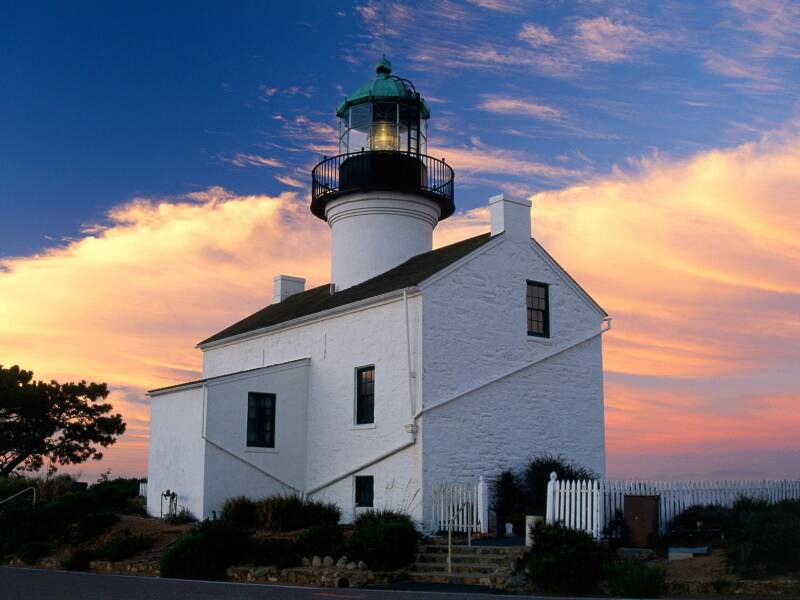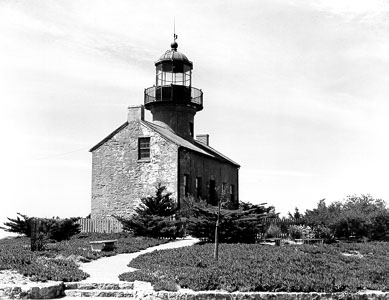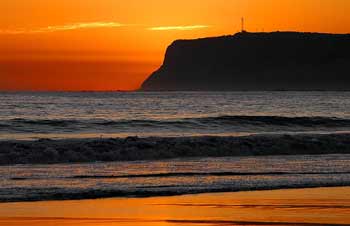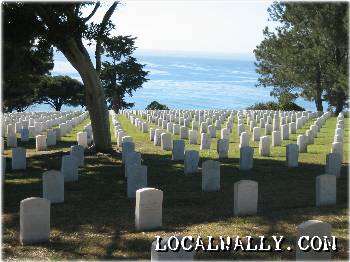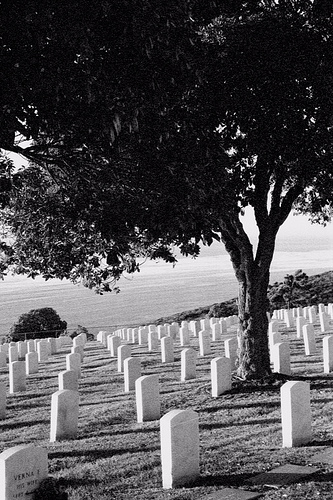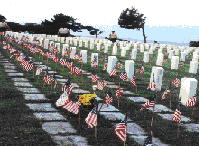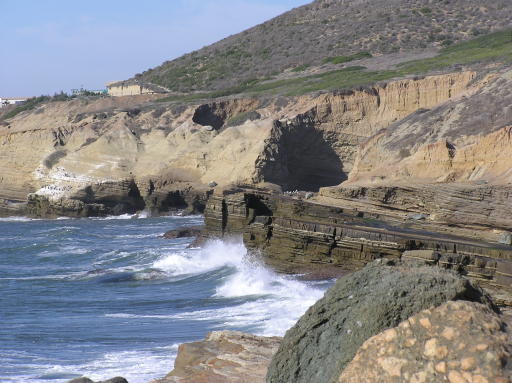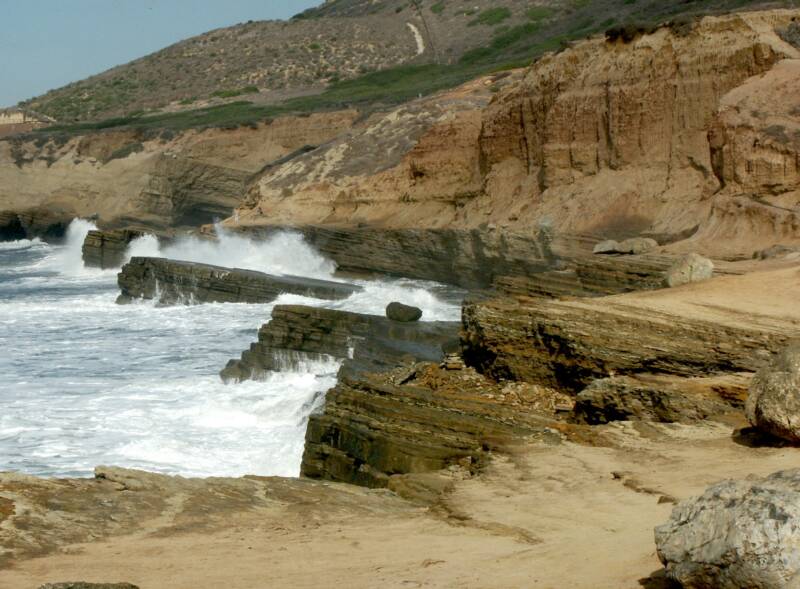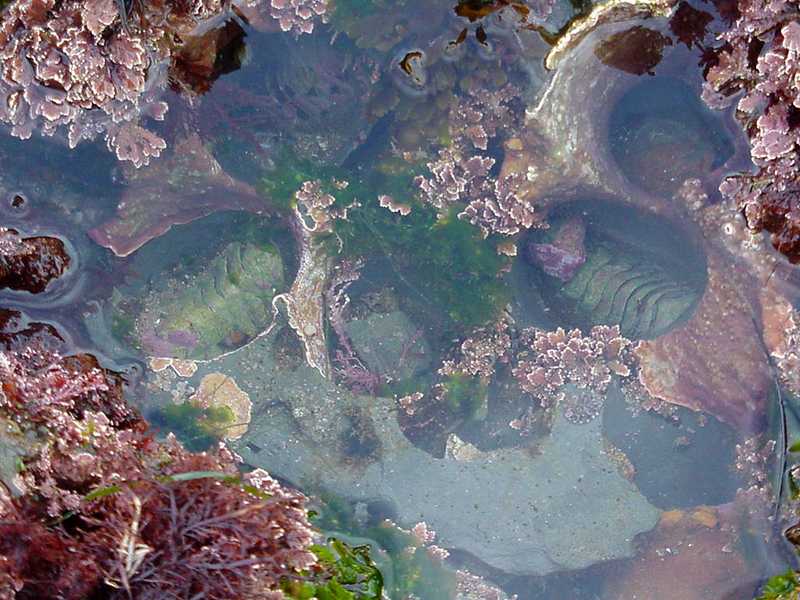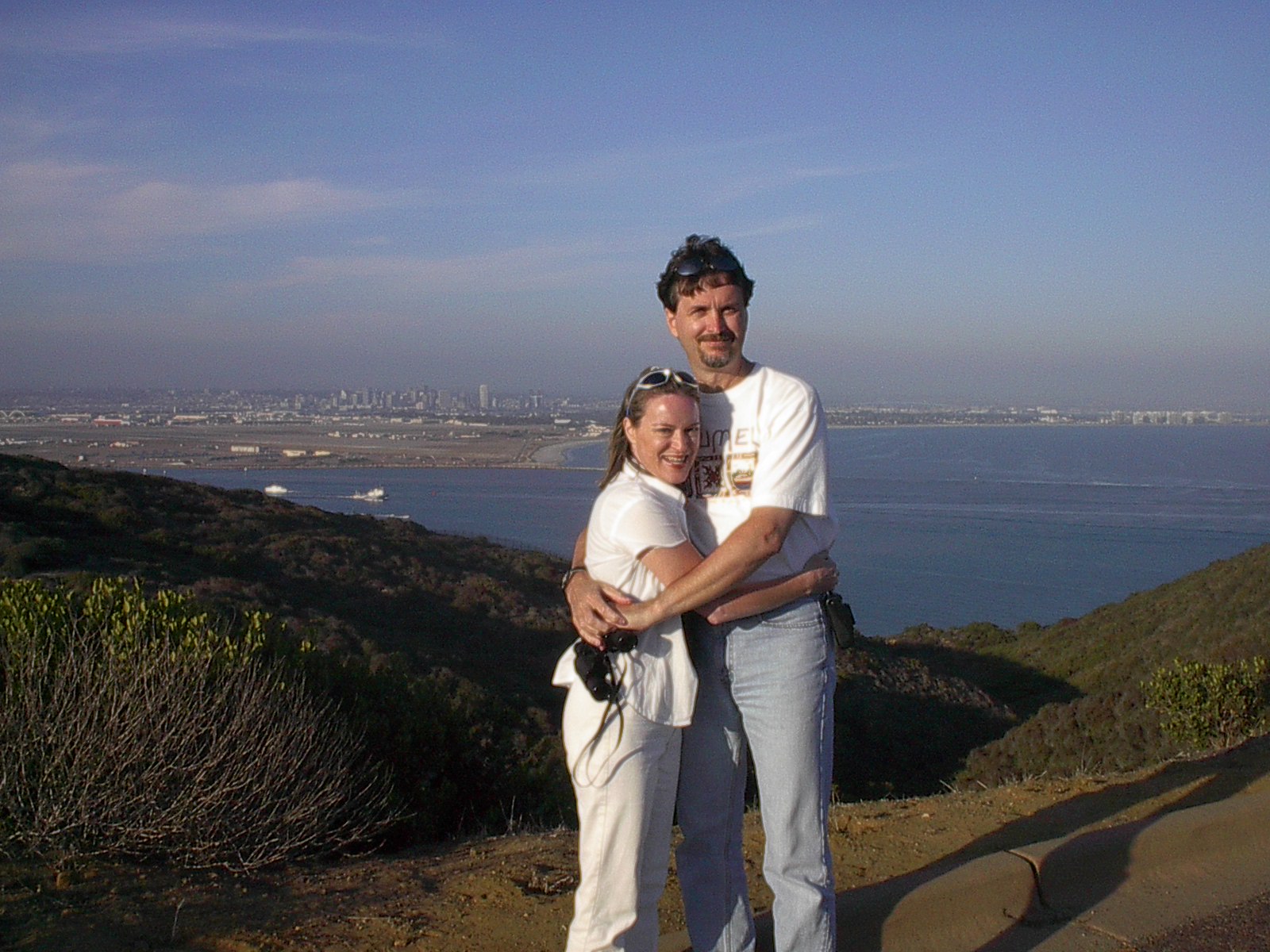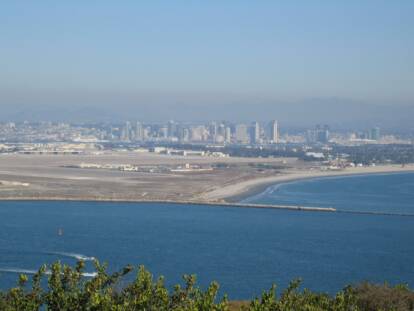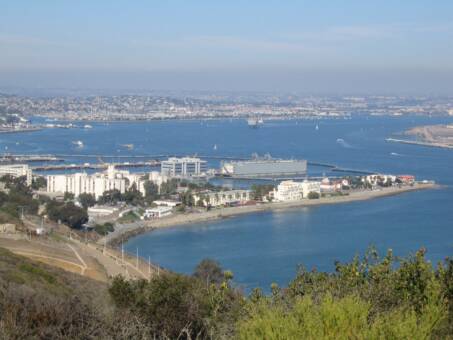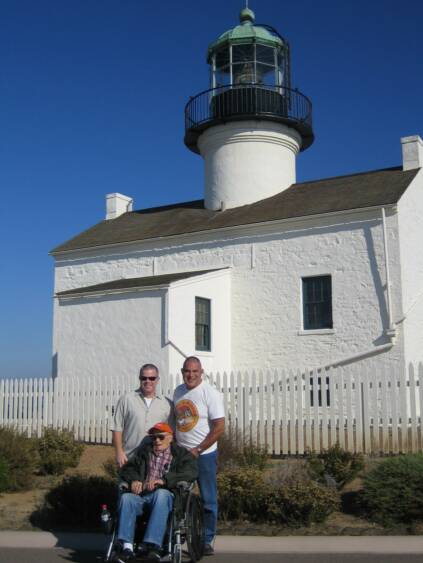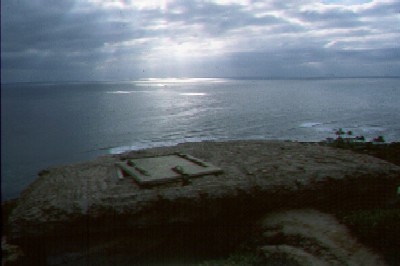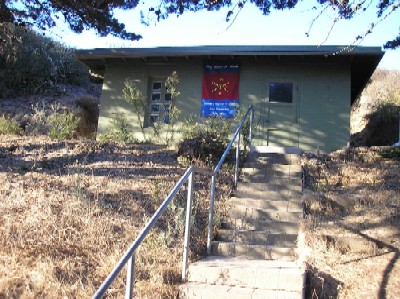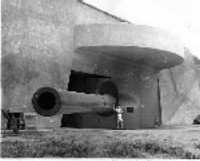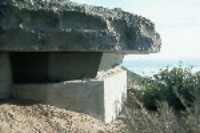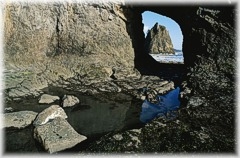HISTORICAL INFORMATION
Many Fort Rosecrans interments date to the early years of the California Territory, including the remains of the casualties of the battle of San Pasqual. Shortly after the United States declared war on Mexico in May 1846, Brigadier Stephen Watts Kearney was tasked with conquering Mexico’s northern provinces, New Mexico and California. While Kearny demonstrated his considerable gift for administrative command with his acquisition of the New Mexican territory, he faced a more difficult task in California. Expecting a show of force from the Mexican Californios, Kearney set out west from New Mexico. Upon reaching California, Kit Carson intercepted him and his men, who informed him the territory had been taken by American settlers in the Bear Flag Revolt. Kearney sent 200 of his men back to New Mexico with the news and continued forward with one-third of his force. Unfortunately, the success of the revolt had been exaggerated and, before reaching their destination, Kearney and his men encountered a group of Californios intent on keeping more U.S. troops out of their homeland.
In the subsequent Battle of San Pasqual, 19 of Kearney’s men and an untold number of Californios lost their lives. Initially, the dead were buried where they fell, but by 1874 the remains had been removed to the San Diego Military Reservation. Eight years later, the bodies were again reinterred at what is now Fort Rosecrans National Cemetery. In 1922, the San Diego chapter of the Native Sons and Daughters of the Golden West had a large boulder brought from the battlefield and placed at the gravesite with a plaque affixed that lists the names of the dead.
Another notable monument in Fort Rosecrans National Cemetery commemorates the deaths of 62 sailors in a boiler explosion aboard the USS Bennington. The Bennington, which had just returned from maneuvers in the Pacific, was anchored in San Diego Harbor. On July 21, 1905, the crew was ordered to depart in search for the USS Wyoming, which had lost a propeller at sea. At approximately 10:30 a.m., an explosion in the boiler room ripped through the ship, killing and wounding the majority of the crew. Two days later the remains of soldiers and sailors were brought to the post cemetery and interred in an area known as Bennington Plot.
Fort Rosecrans became a National Cemetery on Oct. 5, 1934. The decision to make the post cemetery part of the national system came, in part, due to changes in legislation that greatly increased the number of persons eligible for burial in a national cemetery. Grave space in San Francisco National Cemetery then grew increasingly limited. In addition, southern California was experiencing a phenomenal population growth during this period, and there was a definitive need for more burial sites.
Monuments and Memorials
The granite and bronze USS Wasp CV-7 memorial commemorates the loss of fellow shipmates during Battle of Guadalcanal on Sept. 15, 1942.
The San Diego chapter of the Native Sons and Daughters of the Golden West installed the San Pasqual monument in 1922 to honor those soldiers who lost their lives in the 1846 Battle of San Pasqual during the Mexican War. The monument is comprised of a stone boulder with a bronze plaque mounted on it.
The USS Bennington monument is a tall granite obelisk dedicated to the men who lost their lives on that ship in San Diego Harbor on July 21, 1905. The monument was dedicated on Jan. 7, 1908.
The Ommaney Bay CVE-79 monument is an etched granite memorial to the men lost in action when the ship was bombed in January 1945.
The granite Taffy 3 monument was dedicated on Oct. 24, 1996, in memory of the men who died during the 1944 Battle of Leyte Gulf (Philippines) and in subsequent battles of the Pacific.
The granite USS Gambier Bay monument was dedicated on Oct. 25, 1996, in memory of the men who lost their lives during the 1944 Battle of Leyte Gulf (Philippines) and in subsequent battles of the Pacific. Family members and survivors donated the monument.
The USS Hoel, USS Johnston, and USS Samuel B. Roberts monument is a large granite memorial dedicated in 1995 to the men who died on those ships in the 1944 Battle of Leyte Gulf (Philippines).
The USS St. Lo, CVE-63, and Composite Squadron VC-65 was erected in1994 to the memory of the men who died on those ships in the 1944 Battle of Leyte Gulf (Philippines).
A monument dedicated to the Mormon Battalion was erected in 1998.
The Patriots of America memorial was dedicated in 1999 by the California State Society of the Founders and Patriots of America to honor all Americans who answered the call to arms.
The 3rd Infantry Division monument was dedicated on Feb. 16, 2002. The granite memorial is dedicated to their fallen comrades.
back to top
NOTABLE PERSONS
Medal of Honor Recipients
Quartermaster Second Class Charles Francis Bishop (Mexican Campaign), Seizure of Vera Cruz, U.S. Navy. USS Florida, Mexico, April 21, 1914 (Section O, Grave 4562).
Commander Willis W. Bradley (World War I), U.S. Navy. USS Pittsburgh (Section O, Grave 2925).
Major Mason Carter (Indian War Campaign), 5th U. S. Infantry. Bear Paw Mountain, Mont., Sept. 30, 1877 (Section PS-4, Grave 102).
Staff Sergeant Peter S. Connor (Vietnam Conflict), U.S. Marine Corps, Company F, 2nd Battalion. Quang Ngai Province, Republic of Vietnam, Feb. 25, 1966 (Section A-E, Grave 1005).
Boatswain's Mate William S. Cronan, U.S. Navy. USS Bennington, San Diego, Calif., July 21, 1905 (Section T, Grave 534).
Lieutenant Junior Grade Albert L. David (World War II), US Navy. USS Pillsbury French West Africa, June 4, 1944 (Section OS, Grave 125-A).
Corporal James L. Day (World War II), U.S. Marine Corps. Ryukyu Islands, Okinawa, May 14-17, 1945 (Section P, Grave 1748).
Captain Jesse Farley Dyer (Mexican Campaign), U.S. Marine Corps. Vera Cruz, April 21, 1914 (Section P, Grave 1606).
Vice Admiral Middleton S. Elliott (Mexican War), U.S. Navy. Vera Cruz, April 21-22, 1914 (Section P, Grave 2828).
Captain Michael John Estocin (Vietnam Conflict), U.S. Navy. Haiphong, North Vietnam, April 20 & 26, 1967 (Section MA, Grave 112).
Lieutenant Junior Grade Donald A. Gary (World War II), U.S. Navy. Japanese Home Islands near Kobe, Japan, March 19, 1945 (Section A-1, Grave 3-B).
Seaman Ora Graves (World War I), U.S. Navy. USS Pittsburgh, July 23, 1917 (Section W, Grave 1208).
Second Lieutenant Howard Hanneken (World War I), U.S. Marine Corps. Grande Rivera, Republic of Haiti, Oct. 21 & Nov. 1, 1919 (Section C, Grave 166-D).
Gunnery Sergeant Jimmie Earl Howard (Vietnam), U.S. Marine Corps, Company C, 1st Reconnaissance Battalion. Republic of Vietnam, June 16, 1966 (Section O, Grave 3759).
Sergeant Ross L. Iams (Haitian Campaign), U.S. Marine Corps. USS Connecticut, Fort Riviere, Republic of Haiti, Nov. 17, 1915 (Section P, Grave 2930).
Ensign Herbert Charpoit Jones (World War II), U.S. Navy. USS California, Dec. 7, 1941 (Section G, Grave 76).
Coxswain John Edward Murphy (Spanish American War), U.S. Navy. Santiago, Cuba, June 1898 (Section OS, Grave 363).
Sergeant James Irsley Poynter (Korean War), U.S. Marine Corps. Sudong, Korea, Hill 532, Nov. 4, 1950 (Section O, Grave 729).
Sergeant Anund C. Roark (Vietnam War), U.S. Army. Kontum Province, Vietnam, May 16, 1968 (Section O, Grave 1855).
Sergeant Henry Frank Schroeder (Spanish American War), U.S. Army, Company L, 16th U.S. Infantry. Carig, Philippine Island, Sept. 14, 1900 (Section S, Grave 854).
Lieutenant Commander Robert Semple (Mexican War), U.S. Navy. Vera Cruz, April 21, 1914 (Section OS-A, Grave 192).
Lieutenant William Zuiderveld (Mexican War), U.S. Navy. Vera Cruz, April 21, 1914 (Section A-1, Grave 9-B).
Master-at-Arms Second Class Michael A. Monsoor (Iraq War) U.S. Navy, Ramadi, Iraq, Sept. 29, 2006 (Section U, Grave 412E).
Others
Thomas S. Crow was the fourth Master Chief Petty Officer of the Navy and the highest ranking enlisted man. Crow joined the Navy in 1953 and trained as an aviation structural mechanic. He would later work in human relations serving as a race relations specialist and as a manager of a drug and alcohol program. He was selected from a slate of six candidates for the top enlisted man position in 1979. During his tenure he was instrumental in the creation of the Navy’s Senior Enlisted Academy and worked to improve the day-to-day lives of sailors.
Laurence Stallings was a screenwriter with over two dozen writing credits, i.e. What Price Glory."
General Holland Smith, U.S. Marine Corps, commanded FMF in the Pacific during World War II and led the "island hopping" campaign in central Pacific.
Lieutenant General John Wilson “Iron Mike” O'Daniel, U.S. Army, Commanded the 3rd Infantry Division, the Rock of the Marne, during World War II, the first Allied unit into Berchtesgaden in May 1945 (Section A-E, Grave 1172.)
Lt. Gen. Victor H. “Brute” Krulak, USMC, (Ret.), served as commanding general of Fleet Marine Force Pacific during the early years of the Vietnam War. Prior Krulak had served in both the Korean War and World War II. During the later, as a lieutenant colonel, he led a battalion in a diversionary raid to cover the invasion of Bougainville. He was wounded during action but refused to be evacuated; for his bravery, he was awarded the Navy Cross. Earlier in 1937, while stationed in Shanghai, he witnessed a Japanese assault against Chinese forces at the mouth of the Yangtze River in landing craft equipped with a square bow that became a retractable ramp for dispatching troops and equipment. Though he sent photos back to the United States, his report was initially ignored. Later, he consulted with New Orleans boat builder Andrew Higgins on what would become the landing craft used during the invasions of Normandy, Okinawa and Iwo Jima. He retired from the Marine Corps in 1968 and went to work as an executive and columnist for Copley newspapers. In 1984, Krulak penned First to Fight: An Inside View of the U.S. Marine Corps, which is considered the definitive book on the history and culture of the Marine Corps.
Major General Joseph H. Pendleton graduated from the U.S. Naval Academy and was commissioned a second lieutenant in the U.S. Marine Corps in 1884. By 1913, Pendleton had risen to the rank of colonel and was the commanding officer at the Marine Barracks at Puget Sound, where he was on expeditionary duty for much of the time. In mid-1914 after arriving in San Diego, Pendleton began to advocate for the establishment of a major Marine Corps installation in the area due to the location’s favorable weather and harbor. Retiring from military service in 1924, then General Pendleton settled in nearby Coronado where he served as mayor for a time. He died in February 1942. Later that year construction began on a Marine Corps base near Oceanside, California, and in September, Camp Joseph H. Pendleton was official dedicated by President Roosevelt. (Officer Sections, Site 191)
